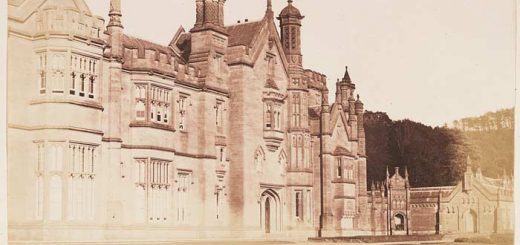Ballyheigue Castle
Designed by Richard Morrison in 1810, Ballyheigue Castle was a grand mansion and home of the Crosbie family. Now mostly a shell, surrounded by a golf course which opened in 1996. It ha been burned down twice, once by accident in 1840 and again on 27th May 1921 as part of the troubles and the destruction of buildings linked to British Imperialism. It is said that the household goods were removed and distributed amongst the community before the locals put it to the torch.
![No machine-readable author provided. Kglavin~commonswiki assumed (based on copyright claims). [CC BY-SA 2.5 (https://creativecommons.org/licenses/by-sa/2.5)], via Wikimedia Commons](http://www.mysteriousbritain.co.uk/wp/wp-content/uploads/2018/12/Ballyheigue_castle-300x225.jpg) There is a story of a ghost and hidden treasure associated with Ballyheigue Castle which appeared in ‘Phantoms Legends, Customs and Superstitions Of The Sea’ (1972) by Raymond Lamont Brown. According to Brown, ‘Ballyheigue (pronounced `baleyhigh’) is a small fishing village with a majestic castle on the Atlantic coast of Eire. Once swarming with smugglers, this part of the Irish coast is quieter now, although a favourite spot with tourists.
There is a story of a ghost and hidden treasure associated with Ballyheigue Castle which appeared in ‘Phantoms Legends, Customs and Superstitions Of The Sea’ (1972) by Raymond Lamont Brown. According to Brown, ‘Ballyheigue (pronounced `baleyhigh’) is a small fishing village with a majestic castle on the Atlantic coast of Eire. Once swarming with smugglers, this part of the Irish coast is quieter now, although a favourite spot with tourists.
In June 1962, Captain P. D. O’Donnell and his family were holidaying at Balyheigue and encountered by chance a strange phantom sailor. Captain O’Donnell later recorded his experiences of the ghost in the magazine ‘Ireland of the Welcomes’ published by Bord Failte Eireann (the Irish Tourist Board).
One afternoon during this holiday O’Donnell and his eight-year-old son Frank set out to explore the shell of Ballyheigue Castle. Once the stronghold of the Crosbie family, who had lorded it over County Kerry for many years, the castle had been burnt to the ground during the Irish ‘troubles’ of 1911. After some investigations of the ruins O’Donnell took several photographs of the mouldering walls and went home.
Curiously enough, when the photographs were developed, one was found to contain ‘another figure’ partly obscured by a square of light which had come from one of the castle windows. The figure held a sword and appeared to be dad in hose or thigh boots. Following careful examination of the proofs and negatives, O’Donnell and several of his friends agreed that the mysterious photograph was not the result of double exposure. Unfortunately, the only print of the snapshot and the negative were subsequently lost in transit to a friend. Try as he might, Captain O’Donnell was not able to find the missing picture, even though he advertised in the Irish newspapers and even had leaflets printed offering a substantial reward. In time, however, the news of his loss and reward travelled widely and O’Donnell had enquiries from as far away as Copenhagen offering to buy the Danish rights to the photograph. Why were the Danes of all people so interested in the photograph of a ghost? Captain O’Donnell decided to investigate.
According to the old chronicles of Kerry, a Danish ship, the Golden Lyon, in the fleet of the Danish Asiatic Company en route from Copenhagen to Tranquebar, was wrecked of Balyheigue strand on October so 1730. Blown of course by a fierce storm, the Golden Lyon became easy prey for the ship-wrecking Crosbies, or so the old legends say. Some still tell how the Crosbies set up false lights on the heads of horses to lure ships ashore. Thinking that the bobbing lights ahead were from other shipping the helmsmen would steer towards them only to wreck their ships among the Atlantic breakers.
The crew of the Golden Lyon were ‘rescued’ by Sir Thomas Crosbie and his men, who salvaged much of the Danish ship’s cargo and some r a chests of silver bars and coin.
Soon after, Sir Thomas Crosbie died suddenly (some say poisoned by his wife). I is wife, lady Margaret, immediately claimed £4,300.00 (110,800.0o) from the Danish ship’s master Captain J. Heitman, for salvage and the loss of her husband, who she claimed had died ‘of his labours and exertions on the night of the wreck’. Fearing for his 12 chests of silver Captain Heitman removed them into the castle’s cellar for safe keeping, mounting a guard at the cellar door until he was able to ship the bullion back to Denmark.
One night shortly afterwards, the castle was raided and the chests of silver were stolen. The authorities subsequently only managed to recover some £5,000.00 ($12,000.00) out of the total £20,000.00 ($48,000.00) worth of silver. Lady Margaret was strongly implicated as having been an instigator of the raid, but publicly denied all knowledge of it. Today various local legends abound as to where the silver went.
Records state that the Danish Silver Raid took place on June 4 1731. Captain O’Donnell’s photograph of the phantom sailor was taken on June 4 1962. Does the sailor, therefore, appear on the anniversary of the raid?
Certainly the silver (the £15,000.00 or so unaccounted for) may still lie somewhere underneath the crumbled walls of Ballyheigue Castle. As there are many other examples of ghostly spirits guarding treasure, maybe the phantom sailor of Ballyheigue Castle stands where the silver is hidden.’




Recent Comments